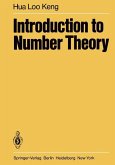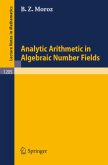E. Grosswald
Representations of Integers as Sums of Squares
E. Grosswald
Representations of Integers as Sums of Squares
- Broschiertes Buch
- Merkliste
- Auf die Merkliste
- Bewerten Bewerten
- Teilen
- Produkt teilen
- Produkterinnerung
- Produkterinnerung
During the academic year 1980-1981 I was teaching at the Technion-the Israeli Institute of Technology-in Haifa. The audience was small, but con sisted of particularly gifted and eager listeners; unfortunately, their back ground varied widely. What could one offer such an audience, so as to do justice to all of them? I decided to discuss representations of natural integers as sums of squares, starting on the most elementary level, but with the inten tion of pushing ahead as far as possible in some of the different directions that offered themselves (quadratic forms, theory of genera,…mehr
Andere Kunden interessierten sich auch für
![Infinite Families of Exact Sums of Squares Formulas, Jacobi Elliptic Functions, Continued Fractions, and Schur Functions Infinite Families of Exact Sums of Squares Formulas, Jacobi Elliptic Functions, Continued Fractions, and Schur Functions]() Stephen C. MilneInfinite Families of Exact Sums of Squares Formulas, Jacobi Elliptic Functions, Continued Fractions, and Schur Functions41,99 €
Stephen C. MilneInfinite Families of Exact Sums of Squares Formulas, Jacobi Elliptic Functions, Continued Fractions, and Schur Functions41,99 €![Introduction to Number Theory Introduction to Number Theory]() L.-K. HuaIntroduction to Number Theory80,99 €
L.-K. HuaIntroduction to Number Theory80,99 €![Modular Functions of One Variable VI Modular Functions of One Variable VI]() Modular Functions of One Variable VI45,99 €
Modular Functions of One Variable VI45,99 €![Class Field Theory Class Field Theory]() J. NeukirchClass Field Theory65,99 €
J. NeukirchClass Field Theory65,99 €![Complex Multiplication Complex Multiplication]() S. LangComplex Multiplication105,99 €
S. LangComplex Multiplication105,99 €![Complex Multiplication Complex Multiplication]() S. LangComplex Multiplication81,99 €
S. LangComplex Multiplication81,99 €![Analytic Arithmetic in Algebraic Number Fields Analytic Arithmetic in Algebraic Number Fields]() Baruch Z. MorozAnalytic Arithmetic in Algebraic Number Fields21,99 €
Baruch Z. MorozAnalytic Arithmetic in Algebraic Number Fields21,99 €-
-
-
During the academic year 1980-1981 I was teaching at the Technion-the Israeli Institute of Technology-in Haifa. The audience was small, but con sisted of particularly gifted and eager listeners; unfortunately, their back ground varied widely. What could one offer such an audience, so as to do justice to all of them? I decided to discuss representations of natural integers as sums of squares, starting on the most elementary level, but with the inten tion of pushing ahead as far as possible in some of the different directions that offered themselves (quadratic forms, theory of genera, generalizations and modern developments, etc.), according to the interests of the audience. A few weeks after the start of the academic year I received a letter from Professor Gian-Carlo Rota, with the suggestion that I submit a manuscript for the Encyclopedia of Mathematical Sciences under his editorship. I answered that I did not have a ready manuscript to offer, but that I could use my notes on representations of integers by sums of squares as the basis for one. Indeed, about that time I had already started thinking about the possibility of such a book and had, in fact, quite precise ideas about the kind of book I wanted it to be.
Hinweis: Dieser Artikel kann nur an eine deutsche Lieferadresse ausgeliefert werden.
Hinweis: Dieser Artikel kann nur an eine deutsche Lieferadresse ausgeliefert werden.
Produktdetails
- Produktdetails
- Verlag: Springer / Springer New York / Springer, Berlin
- Artikelnr. des Verlages: 978-1-4613-8568-4
- Softcover reprint of the original 1st ed. 1985
- Seitenzahl: 268
- Erscheinungstermin: 14. Oktober 2011
- Englisch
- Abmessung: 235mm x 155mm x 15mm
- Gewicht: 411g
- ISBN-13: 9781461385684
- ISBN-10: 1461385687
- Artikelnr.: 36115056
- Herstellerkennzeichnung Die Herstellerinformationen sind derzeit nicht verfügbar.
- Verlag: Springer / Springer New York / Springer, Berlin
- Artikelnr. des Verlages: 978-1-4613-8568-4
- Softcover reprint of the original 1st ed. 1985
- Seitenzahl: 268
- Erscheinungstermin: 14. Oktober 2011
- Englisch
- Abmessung: 235mm x 155mm x 15mm
- Gewicht: 411g
- ISBN-13: 9781461385684
- ISBN-10: 1461385687
- Artikelnr.: 36115056
- Herstellerkennzeichnung Die Herstellerinformationen sind derzeit nicht verfügbar.
1 Preliminaries.- 1. The Problems of Representations and Their Solutions.- 2. Methods.- 3. The Contents of This Book.- 4. References.- 5. Problems.- 6. Notation.- 2 Sums of Two Squares.- 1. The One Square Problem.- 2. The Two Squares Problem.- 3. Some Early Work.- 4. The Main Theorems.- 5. Proof of Theorem 2.- 6. Proof of Theorem 3.- 7. The "Circle Problem".- 8. The Determination of N2(x).- 9. Other Contributions to the Sum of Two Squares Problem.- 10. Problems.- 3 Triangular Numbers and the Representation of Integers as Sums of Four Squares.- 1. Sums of Three Squares.- 2. Three Squares, Four Squares, and Triangular Numbers.- 3. The Proof of Theorem 2.- 4. Main Result.- 5. Other Contributions.- 6. Proof of Theorem 4.- 7. Proof of Lemma 3.- 8. Sketch of Jacobi's Proof of Theorem 4.- 9. Problems.- 4 Representations as Sums of Three Squares.- 1. The First Theorem.- 2. Proof of Theorem 1, Part I.- 3. Early Results.- 4. Quadratic Forms.- 5. Some Needed Lemmas.- 6. Proof of Theorem 1, Part II.- 7. Examples.- 8. Gauss's Theorem.- 9. From Gauss to the Twentieth Century.- 10. The Main Theorem.- 11. Some Results from Number Theory.- 12. The Equivalence of Theorem 4 with Earlier Formulations.- 13. A Sketch of the Proof of (4.7?).- 14. Liouville's Method.- 15. The Average Order of r3(n) and the Number of Representable Integers.- 16. Problems.- 5 Legendre's Theorem.- 1. The Main Theorem and Early Results.- 2. Some Remarks and a Proof That the Conditions Are Necessary.- 3. The Hasse Principle.- 4. Proof of Sufficiency of the Conditions of Theorem 1.- 5. Problems.- 6 Representations of Integers as Sums of Nonvanishing Squares.- 1. Representations by k ? 4 Squares.- 2. Representations by k Nonvanishing Squares.- 3. Representations as Sums of Four Nonvanishing Squares.- 4. Representations as Sums of Two Nonvanishing Squares.- 5. Representations as Sums of Three Nonvanishing Squares.- 6. On the Number of Integers n ? x That Are Sumsof k Nonvanishing Squares.- 7. Problems.- 7 The Problem of the Uniqueness of Essentially Distinct Representations.- 1. The Problem.- 2. Some Preliminary Remarks.- 3. The Case k = 4.- 4. The Case k ? 5.- 5. The Cases k = 1 and k = 2.- 6. The Case k = 3.- 7. Problems.- 8 Theta Functions.- 1. Introduction.- 2. Preliminaries.- 3. Poisson Summation and Lipschitz's Formula.- 4. The Theta Functions.- 5. The Zeros of the Theta Functions.- 6. Product Formulae.- 7. Some Elliptic Functions.- 8. Addition Formulae.- 9. Problems.- 9 Representations of Integers as Sums of an Even Number of Squares.- 1. A Sketch of the Method.- 2. Lambert Series.- 3. The Computation of the Powers ?32k.- 4. Representation of Powers of ?3 by Lambert Series.- 5. Expansions of Lambert Series into Divisor Functions.- 6. The Values of the rk(n) for Even k ? 12.- 7. The Size of rk(n) for Even k ? 8.- 8. An Auxilliary Lemma.- 9. Estimate of r10(n) and r12(n).- 10. An Alternative Approach.- 11. Problems.- 10 Various Results on Representations as Sums of Squares.- 1. Some Special, Older Results.- 2. More Recent Contributions.- 3. The Multiplicativity Problem.- 4. Problems.- 11 Preliminaries to the Circle Method and the Method of Modular Functions.- 1. Introduction.- 2. Farey Series.- 3. Gaussian Sums.- 4. The Modular Group and Its Subgroups.- 5. Modular Forms.- 6. Some Theorems.- 7. The Theta Functions as Modular Forais.- 8. Problems.- 12 The Circle Method.- 1. The Principle of the Method.- 2. The Evaluation of the Error Terms and Formula for rs(n).- 3. Evaluation of the Singular Series.- 4. Explicit Evaluation of L.- 5. Discussion of the Density of Representations.- 6. Other Approaches.- 7. Problems.- 13 Alternative Methods for Evaluating rs(n).- 1. Estermann's Proof.- 2. Sketch of the Proof by Modular Functions.- 3. The Function ?s(?).- 4. The Expansion of ?s(?) at the Cusp ? = -1.- 5. The Function ?s(?).- 6. Proof of Theorem 4.- 7. Modular Functions and the Number of Representations by Quadratic Forms.- 8. Problems.- 14 Recent Work.- 1. Introduction.- 2. Notation and Definitions.- 3. The Representation of Totally Positive Algebraic Integers as Sums of Squares.- 4. Some Special Results.- 5. The Circle Problem in Algebraic Number Fields.- 6. Hilbert's 17th Problem.- 7. The Work of Artin.- 8. From Artin to Pfister.- 9. The Work of Pfister and Related Work.- 10. Some Comments and Additions.- 11. Hilbert's 11th Problem.- 12. The Classification Problem and Related Topics.- 13. Quadratic Forms Over ?p.- 14. The Hasse Principle.- Appendix Open Problems.- References.- Addenda.- Author Index.
1 Preliminaries.- 1. The Problems of Representations and Their Solutions.- 2. Methods.- 3. The Contents of This Book.- 4. References.- 5. Problems.- 6. Notation.- 2 Sums of Two Squares.- 1. The One Square Problem.- 2. The Two Squares Problem.- 3. Some Early Work.- 4. The Main Theorems.- 5. Proof of Theorem 2.- 6. Proof of Theorem 3.- 7. The "Circle Problem".- 8. The Determination of N2(x).- 9. Other Contributions to the Sum of Two Squares Problem.- 10. Problems.- 3 Triangular Numbers and the Representation of Integers as Sums of Four Squares.- 1. Sums of Three Squares.- 2. Three Squares, Four Squares, and Triangular Numbers.- 3. The Proof of Theorem 2.- 4. Main Result.- 5. Other Contributions.- 6. Proof of Theorem 4.- 7. Proof of Lemma 3.- 8. Sketch of Jacobi's Proof of Theorem 4.- 9. Problems.- 4 Representations as Sums of Three Squares.- 1. The First Theorem.- 2. Proof of Theorem 1, Part I.- 3. Early Results.- 4. Quadratic Forms.- 5. Some Needed Lemmas.- 6. Proof of Theorem 1, Part II.- 7. Examples.- 8. Gauss's Theorem.- 9. From Gauss to the Twentieth Century.- 10. The Main Theorem.- 11. Some Results from Number Theory.- 12. The Equivalence of Theorem 4 with Earlier Formulations.- 13. A Sketch of the Proof of (4.7?).- 14. Liouville's Method.- 15. The Average Order of r3(n) and the Number of Representable Integers.- 16. Problems.- 5 Legendre's Theorem.- 1. The Main Theorem and Early Results.- 2. Some Remarks and a Proof That the Conditions Are Necessary.- 3. The Hasse Principle.- 4. Proof of Sufficiency of the Conditions of Theorem 1.- 5. Problems.- 6 Representations of Integers as Sums of Nonvanishing Squares.- 1. Representations by k ? 4 Squares.- 2. Representations by k Nonvanishing Squares.- 3. Representations as Sums of Four Nonvanishing Squares.- 4. Representations as Sums of Two Nonvanishing Squares.- 5. Representations as Sums of Three Nonvanishing Squares.- 6. On the Number of Integers n ? x That Are Sumsof k Nonvanishing Squares.- 7. Problems.- 7 The Problem of the Uniqueness of Essentially Distinct Representations.- 1. The Problem.- 2. Some Preliminary Remarks.- 3. The Case k = 4.- 4. The Case k ? 5.- 5. The Cases k = 1 and k = 2.- 6. The Case k = 3.- 7. Problems.- 8 Theta Functions.- 1. Introduction.- 2. Preliminaries.- 3. Poisson Summation and Lipschitz's Formula.- 4. The Theta Functions.- 5. The Zeros of the Theta Functions.- 6. Product Formulae.- 7. Some Elliptic Functions.- 8. Addition Formulae.- 9. Problems.- 9 Representations of Integers as Sums of an Even Number of Squares.- 1. A Sketch of the Method.- 2. Lambert Series.- 3. The Computation of the Powers ?32k.- 4. Representation of Powers of ?3 by Lambert Series.- 5. Expansions of Lambert Series into Divisor Functions.- 6. The Values of the rk(n) for Even k ? 12.- 7. The Size of rk(n) for Even k ? 8.- 8. An Auxilliary Lemma.- 9. Estimate of r10(n) and r12(n).- 10. An Alternative Approach.- 11. Problems.- 10 Various Results on Representations as Sums of Squares.- 1. Some Special, Older Results.- 2. More Recent Contributions.- 3. The Multiplicativity Problem.- 4. Problems.- 11 Preliminaries to the Circle Method and the Method of Modular Functions.- 1. Introduction.- 2. Farey Series.- 3. Gaussian Sums.- 4. The Modular Group and Its Subgroups.- 5. Modular Forms.- 6. Some Theorems.- 7. The Theta Functions as Modular Forais.- 8. Problems.- 12 The Circle Method.- 1. The Principle of the Method.- 2. The Evaluation of the Error Terms and Formula for rs(n).- 3. Evaluation of the Singular Series.- 4. Explicit Evaluation of L.- 5. Discussion of the Density of Representations.- 6. Other Approaches.- 7. Problems.- 13 Alternative Methods for Evaluating rs(n).- 1. Estermann's Proof.- 2. Sketch of the Proof by Modular Functions.- 3. The Function ?s(?).- 4. The Expansion of ?s(?) at the Cusp ? = -1.- 5. The Function ?s(?).- 6. Proof of Theorem 4.- 7. Modular Functions and the Number of Representations by Quadratic Forms.- 8. Problems.- 14 Recent Work.- 1. Introduction.- 2. Notation and Definitions.- 3. The Representation of Totally Positive Algebraic Integers as Sums of Squares.- 4. Some Special Results.- 5. The Circle Problem in Algebraic Number Fields.- 6. Hilbert's 17th Problem.- 7. The Work of Artin.- 8. From Artin to Pfister.- 9. The Work of Pfister and Related Work.- 10. Some Comments and Additions.- 11. Hilbert's 11th Problem.- 12. The Classification Problem and Related Topics.- 13. Quadratic Forms Over ?p.- 14. The Hasse Principle.- Appendix Open Problems.- References.- Addenda.- Author Index.








